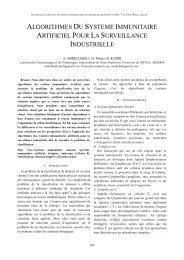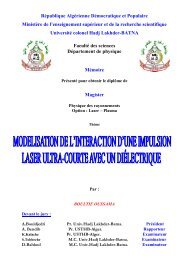Europe's Quest for the Universe - Laboratoires de Recherche
Europe's Quest for the Universe - Laboratoires de Recherche
Europe's Quest for the Universe - Laboratoires de Recherche
You also want an ePaper? Increase the reach of your titles
YUMPU automatically turns print PDFs into web optimized ePapers that Google loves.
Introduction<br />
The progress of science <strong>de</strong>pends on <strong>the</strong> technological <strong>de</strong>velopment of<br />
its instrumentation. This is particularly true <strong>for</strong> <strong>the</strong> astronomical sciences<br />
where <strong>the</strong> study of remote objects requires sophisticated and costly <strong>de</strong>tection<br />
techniques. In this book I shall analyze some of <strong>the</strong> large European astronomical<br />
projects, both on <strong>the</strong> ground and in space, <strong>the</strong>ir <strong>de</strong>velopment during<br />
<strong>the</strong> last two <strong>de</strong>ca<strong>de</strong>s, and <strong>the</strong>ir prospects in <strong>the</strong> future. While scientific<br />
progress is intimately related to technology <strong>de</strong>velopment, both are contingent<br />
on professionals and funding, and I shall consi<strong>de</strong>r <strong>the</strong> situation with<br />
regard to both of <strong>the</strong>se.<br />
This book is addressed to a varied audience: scientists who wish to see<br />
what is happening outsi<strong>de</strong> <strong>the</strong>ir own domain, stu<strong>de</strong>nts who look <strong>for</strong> fruitful<br />
areas of <strong>the</strong>sis research, functionaries who need some background <strong>for</strong> <strong>de</strong>cision<br />
making, amateur astronomers interested in knowing what is going on<br />
in <strong>the</strong> profession, and also to an educated public that wants to get <strong>the</strong> flavor<br />
of what is behind <strong>the</strong> newspaper articles reporting scientific results and to<br />
know how European activities compare to what is being done elsewhere. The<br />
more <strong>de</strong>tailed <strong>de</strong>scription of <strong>the</strong> <strong>de</strong>velopment of <strong>the</strong> VLT, ESO’s Very Large<br />
Telescope, illustrates how a large technological project gets un<strong>de</strong>rway and<br />
after some pitfalls reaches completion.<br />
In <strong>the</strong> first half of <strong>the</strong> twentieth century observational astronomy was<br />
ipso facto astronomy done from <strong>the</strong> ground in <strong>the</strong> visible part of <strong>the</strong> spectrum.<br />
While in <strong>the</strong> USA ever larger telescopes were being built, in Europe<br />
<strong>de</strong>velopments were much more mo<strong>de</strong>st, partly owing to unsuitable meteorological<br />
conditions, but even more because private donors on <strong>the</strong> scale of an<br />
Andrew Carnegie did not exist here. In <strong>the</strong> early fifties some proposals were<br />
ma<strong>de</strong> to construct a large European telescope at a suitable location. Political<br />
and financial conditions <strong>for</strong> science were much improving, and in 1964 ESO,<br />
<strong>the</strong> European Sou<strong>the</strong>rn Observatory, was foun<strong>de</strong>d by half a dozen countries<br />
as an intergovernmental organization; in <strong>the</strong> meantime most countries in<br />
Western Europe have become members. In writing this book, I have placed<br />
ESO at <strong>the</strong> beginning because of its increasing role in several areas of<br />
European astronomy.<br />
The early evolution of ESO has been well <strong>de</strong>scribed by Adriaan Blaauw<br />
in his book “ESO’s Early History” 1) , so I shall give only a brief recapitulation<br />
and <strong>the</strong>n sketch <strong>the</strong> origin of <strong>the</strong> VLT, which has brought Europe to <strong>the</strong> <strong>for</strong>efront<br />
of contemporary optical astronomy. Following a brief overview of <strong>the</strong>






